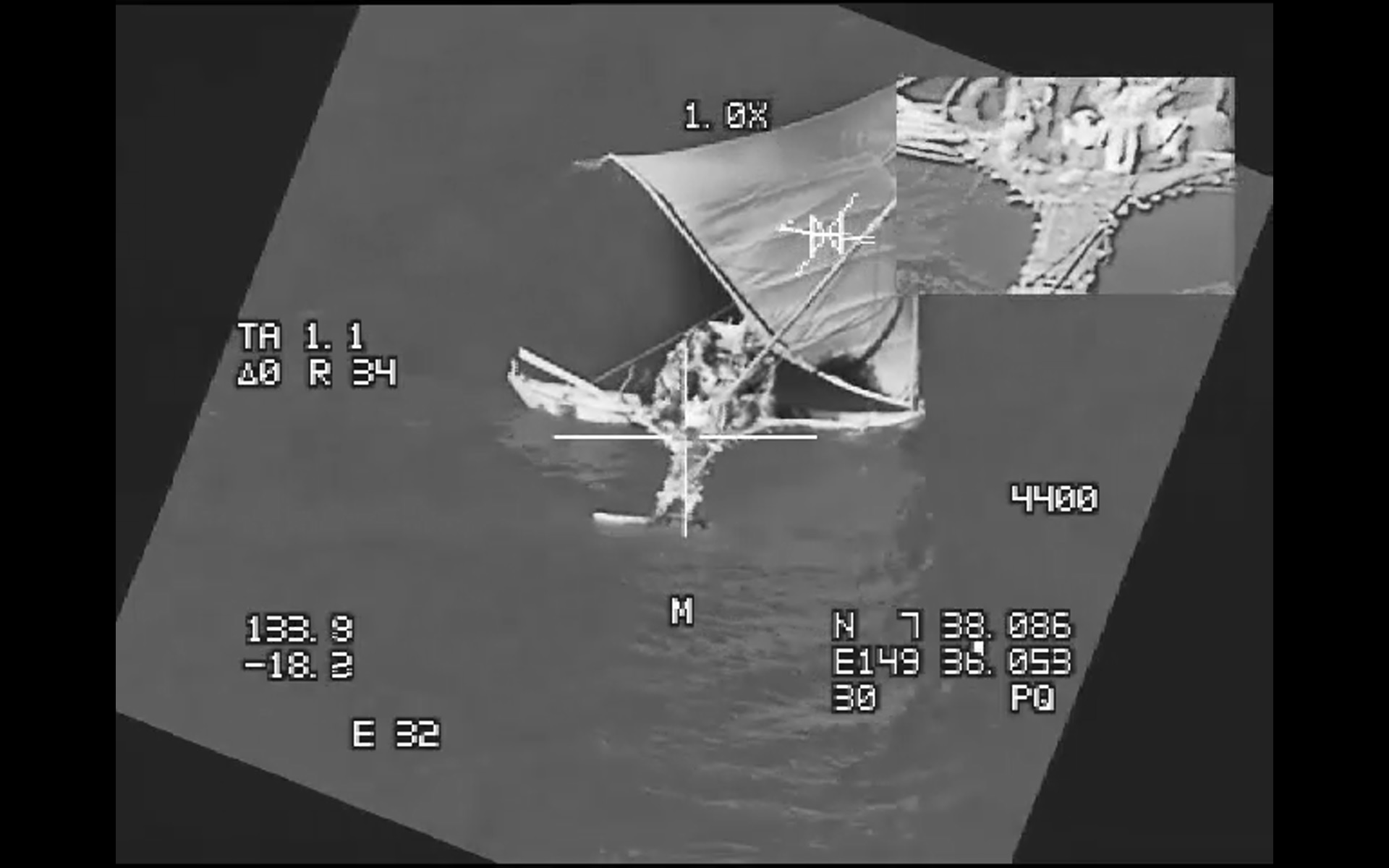
Six passengers aboard a canoe were located in a joint search and rescue mission June 25, 2018, in the Pacific Ocean Southwest of Guam. Photo by TSgt. Jake Barreiro?.
ANDERSEN AFB, Guam—Two B-52s and airmen from the 20th Expeditionary Bomb Squadron were flying a regular training sortie on June 25 as part of the Air Force’s continuous bomber presence in the Pacific, practicing dropping bombs on a training range north of Guam when an unusual and urgent call came in.
The US Coast Guard called the squadron’s operations center with a real-world tasking—a small sailing skiff has been missing for six days south of the island, and they needed help.
The only aircraft available and ready were the two B-52s, which had taken off with training munitions and Raider call signs to train at the isolated island north of Guam. The B-52s headed south, about 350 nautical miles off the shore of Guam and were tasked with checking out two coordinates where the ship could be.
“That’s another advantage of the B-52, we have long legs and we carry a lot of fuel,” said Lt. Col. Jarred Prier, the director of operations for the 20th EBS.
The bombers set up two tracks to fly up and down the area, with a search grid of 230 nautical miles north to south, 500 nautical miles east to west. The pilots searched with their eyes, while “offense” and “defense” airmen—the weapons systems and electronic warfare officers, respectively—used the bomber’s SNIPER pod to search. The real-world tasking now also had training value.
The B-52s arrived at the first coordinate, near a small chain of islands, and initially didn’t see anything. The boat, which was described in the initial radio call from operations as “like the one in Moana”—the Disney animated movie—didn’t have metal, so it wouldn’t reflect sunlight back into the air or give a radar return.
When they arrived, the bombers switched to “best endurance,” the speed and altitude to use the least amount of fuel so they could search as long as possible. They figured they had “about an hour of playtime,” said 1st Lt. Jordan Allen, a pilot on one of the aircraft.
The bombers decided to do more passes to be sure. Capt. Sean Simpson, the aircraft commander of one of the jets, spotted a tiny white speck to his left. The bomber flew closer, ad other members of the crew climbed up in the cockpit to try to see the speck as well. The back of the jet trained the SNIPER pod on the location. The pod’s grainy monochrome footage showed the boat, with the six wayward sailors waving into the sky as if to say “no kidding, help us,” Allen said. The bomber marked the coordinates for the Coast Guard and stuck around as long as they could before heading home.
Bomber crews searched the area for just 45 minutes, and located the sailors less than four hours after the call. The bomber’s “long legs” and capable sensor suite was able to find the lost boat quickly, but it was almost miraculous that the crew spotted the boat. Flying at 19,000 feet, to spot a boat with a 12-foot sail. There were “puffies”—small white clouds—everywhere, blocking the crew’s view of the ocean.
While the boat was spotted relatively quickly, it would take much longer for the crew to be reached. The nearest ship was 74 miles away, and didn’t make contact until several hours later. The crew did not want to be rescued, instead asked for direction and additional supplies. They eventually made landfall mid-morning on Tuesday.
The mission, which forced the crews to immediately shift from direct attack to maritime surveillance without a filed instrument flight plan, was “seamless, Prier said. The crews had been deployed since January, and this was effectively the “capstone” of the deployment.”
“It shows how far we’ve come and how well trained we are to accomplish this mission,” Prier said.
B-52 crews train extensively to drop bombs and destroy an enemy effectively, so it was “nice to do something we don’t do a lot,” Simpson said. “We’re excited to help.”